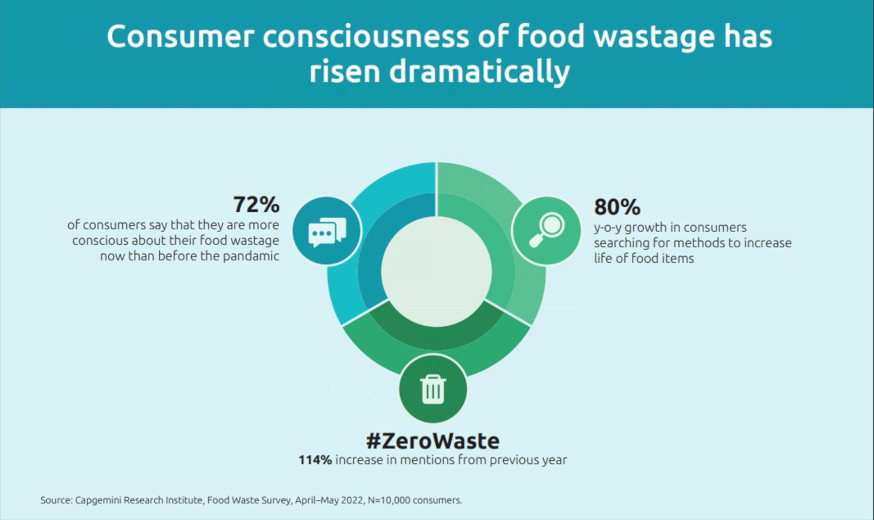
Consumer consciousness regarding food waste grew to 72% in the past two years. It is one of the population’s main concerns, together with rising food prices, supply chain challenges and the pandemic, with an impact on their behavior.
Today, 72% of consumers are aware of their food wastage; by comparison, this ratio was 33% in 2020, according to a report published by the Capgemini Research Institute. For the report, titled “Reflect. Rethink. Reconsider. Why food waste is everybody’s problem”, the institute surveyed 10,000 consumers and executives from 1,000 large organizations in food manufacturing and retail.
Consumers are already looking into ways to reduce their food waste: there is an 80% year-on-year growth in social media searches for methods to increase the life of food items, the research shows. Cost savings (56%), concerns around world hunger (52%) and climate change (51%) are the primary reasons contributing to this.
Looking into the causes of food waste, consumers take responsibility, with 60% feeling guilty about wasting food. However, they also think that retailers and food manufacturers are not doing enough to help them curb this issue. Nearly two-thirds (61%) of consumers want brands and retailers to do more to help them tackle food waste and 57% are disappointed as they feel that businesses don’t care enough about the issue.
There are organizations tackling food waste in-store, in consumers’ homes, as well as providing tips to ensure leftovers are not wasted, the research shows. But, consumers do not believe these actions are enough. For instance, 60% of organizations say that they help consumers understand terms like “best before”, “consume by” and “expiry date”, but only 39% of consumers are satisfied that this information is clear enough.
Consumers want organizations to do more in areas such as product innovation, packaging, clarity of date labels, and consumer education. For instance, consumers would like to see digital labels (QR codes, etc.) that will provide them with more information on the product’s journey and quality.
The study reveals that consumers feel they are too often left to their own devices regarding reducing food waste. When it comes to increasing food longevity at home, two-thirds (67%) are going to third-party sources for information (friends, family, influencers, and social media) with only a third (33%) getting information from packaging, commercials or campaigns run by food manufacturers and retailers.
More support wanted
As consumer awareness around the issue of food waste grows, food retailers and manufacturers must take action to win consumer confidence, the report concludes: 91% of consumers say that they are willing to buy from brands and retailers that disclose information on their food waste, while 58% will increase their spend with companies taking active steps to manage food waste.
“The increased awareness amongst consumers and the initiatives being taken by businesses to tackle food waste is a positive step forward”, said Tim Bridges, Global Sector Lead, Consumer Products, Retail and Distribution at Capgemini. “With the help of technology, organizations can track and assess food waste at every stage of the food value chain to enable action at the right time, while also engaging with their consumers by inculcating waste-avoiding behaviors and making them an active participant in waste reduction. An agile, intelligent supply chain can also enable an effective collaboration across the value chain to create a sustainable and future-ready ecosystem.”
A fragmented food chain
Although reducing food waste at the retail and consumption phase is an important facet, much more food is lost during production and distribution (1.5bn tons vs 931m tons).[1] More than three in four (77%) organizations say they have committed to the United Nations’ Sustainability Development Goals 12.3 (UN SDG 12.3), a framework that focuses on halving per-capita food waste at retail and consumer levels and reducing food losses along production and supply chains, including post-harvest losses, by 2030. However, only 15% of organizations say they have achieved or are on track to achieve their targets.
According to the report, this is due to a fragmented approach to addressing food waste and loss across the food chain. Although food retailers and manufacturers focus on reducing food waste in upstream logistics (44% of retailers and 50% of manufacturers) and processing and packaging (43% retailers, 46% manufacturers), few players pay the same attention to agricultural production (22% retailers and 23% manufacturers) or downstream storage (18% retailers and 21% manufacturers). With produce often crossing international borders, getting a handle on where, when, and how much food loss and waste is occurring is proving a challenge for manufacturers and retailers.

Technology can help
The report recommends an approach to tackle food waste, backed by technology:
- Engaging consumers and employees in food waste management initiatives: organizations can use technology to inculcate waste-avoiding behaviors among consumers, bolster awareness initiatives and incentivize employees to encourage proactive behavior
- Collaborating across the value chain: implementing and scaling technology solutions such as data-driven demand forecasting, temperature monitoring, and inventory management can help organizations maximize impact. An agile and intelligent supply chain with data-sharing ecosystems and increased collaboration across the wider ecosystem can help accelerate change
- Setting, monitoring, and reporting food waste-related metrics: organizations need to set up goals, measure progress, and have the right governance structure in place to understand the root causes of waste, and course correction mechanisms. With the right use of technology, organizations can track, assess, report, and reduce food waste across the value chain.
The global survey was conducted in 11 countries across North America, Europe, and Asia Pacific in April and May 2022.
————————-
[1] WWF, “Over 15% of food is lost before leaving the farm – WWF report,” July 21, 2021.
[1] United Nations Environment Programme, “Definition of food loss and waste, “UN: 17% of all food available at consumer levels is wasted,” March 4, 2021.
Photo: Laura James, Pexels


